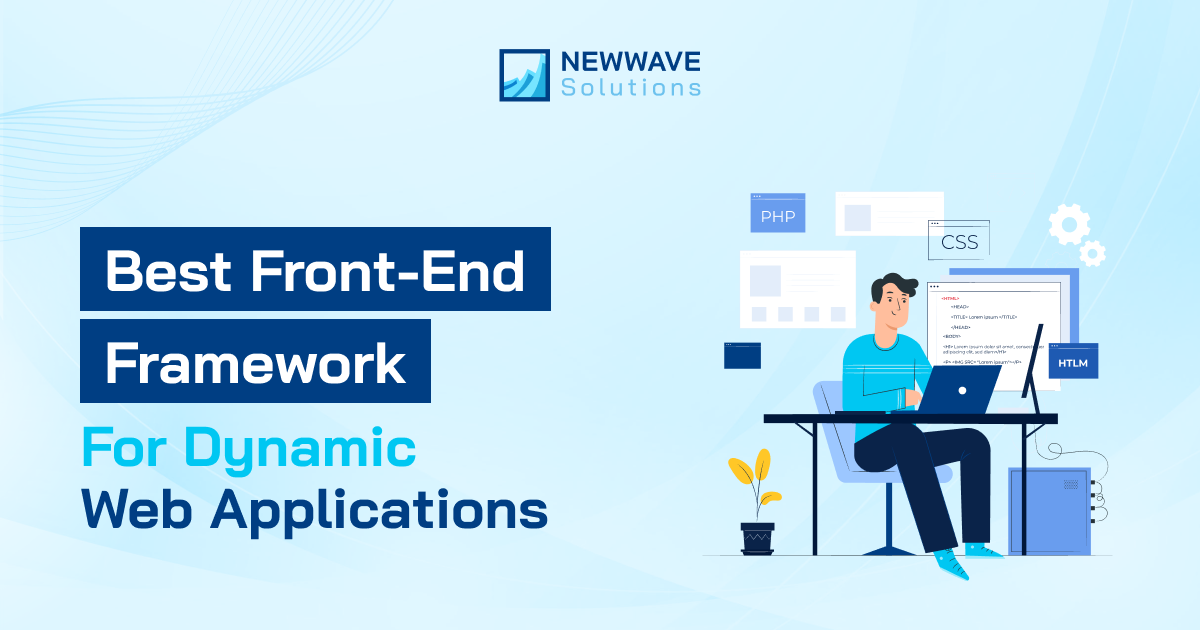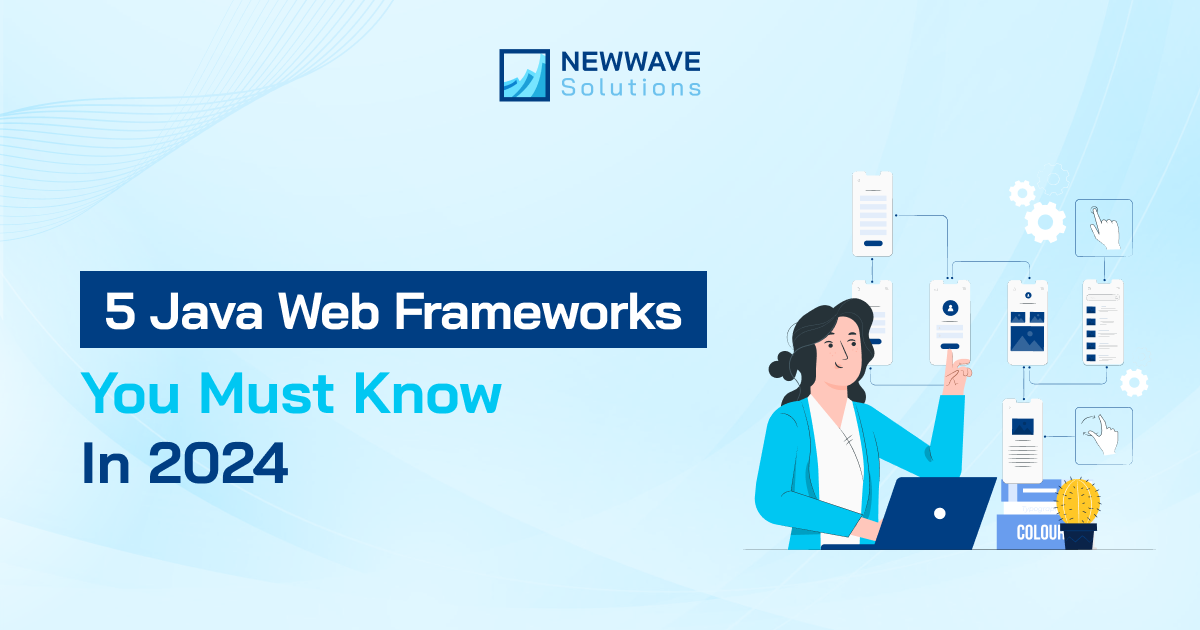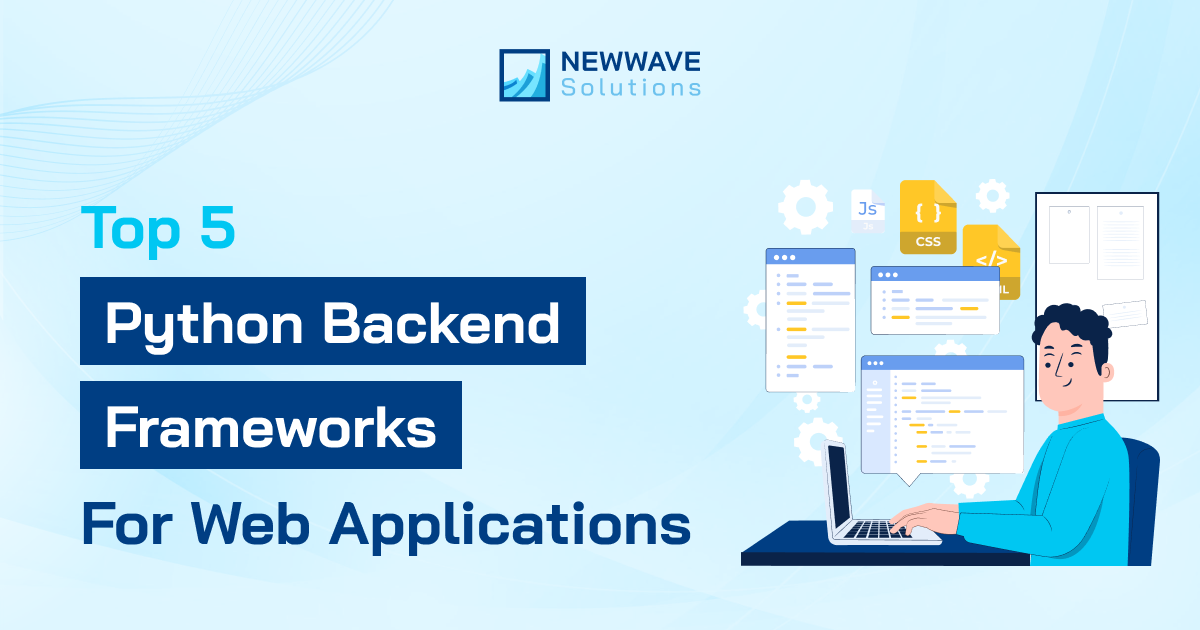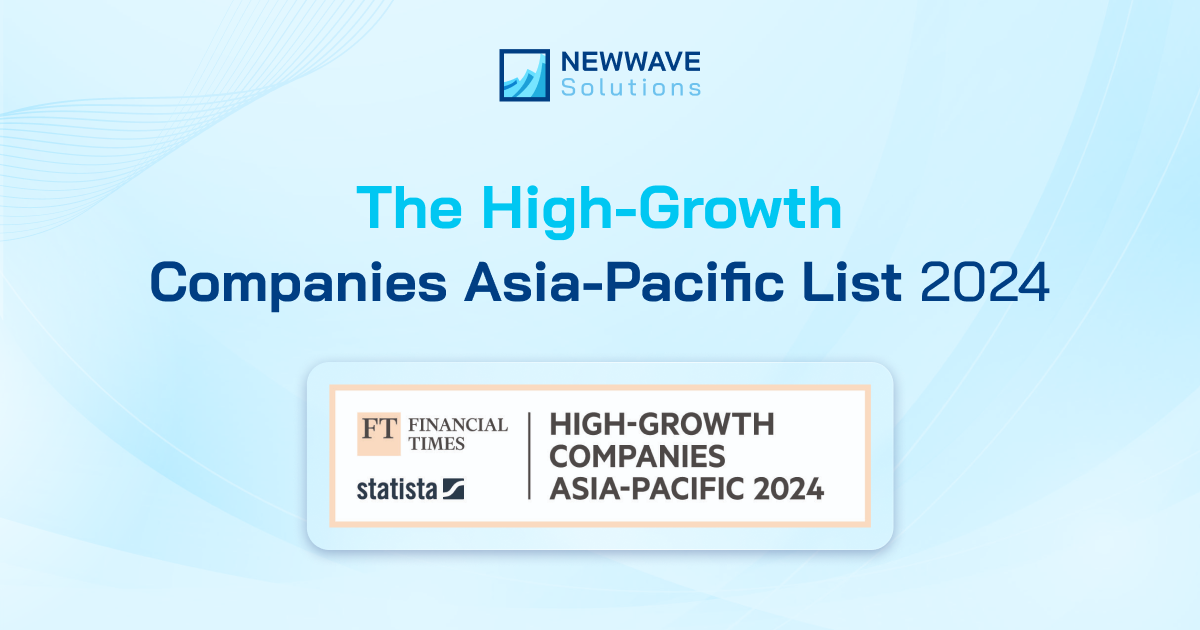

Must-Know 5 Best Web App Frameworks for Web Development
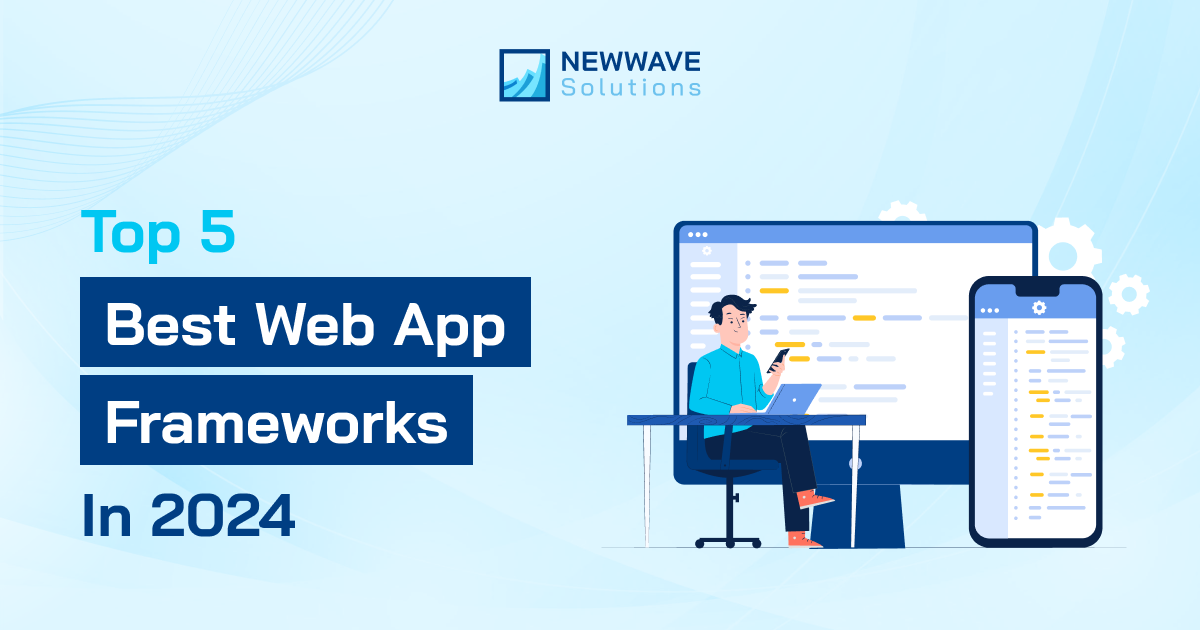
In today’s fast-paced digital landscape, web applications are essential. From social media to e-commerce, web apps have revolutionized how we interact online. As the need for robust, user-friendly, and high-performing web apps grows, developers seek the best web app development frameworks to streamline development and deliver exceptional user experiences.
This blog post explores the top web app frameworks for 2024, including options for building progressive web apps (PWAs). We’ll highlight features, advantages, and how they fit various project needs.
Table Of Contents
Toggle1. What is a Web App Framework?
The world of web development offers a vast array of top web app frameworks, each with its strengths and ideal use cases. Selecting the best web app framework depends on your project’s specific requirements and your development team’s expertise. This guide will introduce you to some of the most popular options, including progressive web app frameworks and frameworks built for Java environments.

In essence, a web app framework is a collection of tools and libraries designed to streamline the development process for web applications. These frameworks, encompassing both best web app development frameworks and progressive web app frameworks, provide a structured foundation upon which you can build your application.
They offer pre-written code for common tasks, like routing and data handling, allowing developers to focus on the unique functionality of your app. This not only saves development time but also promotes the creation of maintainable and scalable applications.
By leveraging features like routing mechanisms, templating engines, and modular architectures, these frameworks empower developers to craft efficient and robust web applications. Java web app frameworks provide a specific solution for those comfortable within the Java development environment.
1.1. Advantages of Using Web Development Frameworks
Selecting the best web app framework can significantly impact your development process. Frameworks offer a plethora of advantages, making them a popular choice for building modern web applications. Here’s a breakdown of some key benefits to consider when choosing the top web app frameworks for your project:
- Increased Productivity
- Consistent Coding Standards
- Enhanced Security
- Scalability and Maintainability
- Community Support

For applications that require offline functionality or a mobile-like experience, a progressive web app framework might be the ideal choice. PWAs leverage the advantages of web frameworks while offering features typically associated with native mobile apps.
Java is a popular programming language for building web applications. If your project utilizes Java, there are numerous Java web app frameworks available that cater specifically to Java development.
By carefully considering these factors and the specific needs of your project, you can make an informed decision and choose the best web app framework to build a robust, secure, and scalable web application.
2. Choosing the Right Framework for Your Web App Project
Selecting the most suitable top web app framework is crucial for the success of your project. Consider the following factors when evaluating different best web app frameworks for your web application:
- Project Requirements: Consider the complexity of your application, its target audience, and any specific functionalities it needs. For instance, progressive web app frameworks are well-suited for applications that require offline functionality, making them a great choice for applications that need to be accessible even without an internet connection.
- Team Expertise: The skillset of your development team plays a crucial role. If your team is proficient in Java, then a Java web app framework might be a natural choice. This ensures a smoother development process by leveraging your team’s existing knowledge.
- Community and Ecosystem: Frameworks with a large and active community tend to have better documentation, support, and third-party libraries, which can significantly contribute to the development process. This extensive ecosystem surrounding the best web app framework can save your team time and resources.
- Long-term Support and Roadmap: Evaluate the framework’s roadmap and commitment to ongoing development and maintenance to ensure its longevity and compatibility with future web standards. Choosing a framework with a clear roadmap ensures your application stays up-to-date and avoids compatibility issues down the line.
- Performance and Optimization: Consider the framework’s performance capabilities, especially for data-intensive or resource-heavy applications, to deliver a seamless user experience. By choosing a well-optimized best web app framework, you can ensure your application runs smoothly even under heavy use.
By carefully considering these factors and the specific needs of your project, you can make an informed decision and select the best progressive web app framework or any other type of web app framework that best suits your development needs.
See more: Top 5 High-Performance Python Backend Frameworks For Web Applications
3. Top Best Web App Frameworks for Enhanced User Engagement
Choosing the best web app framework can be overwhelming. There are numerous options available, each with its strengths and weaknesses. This article explores ReactJS, a popular contender in the realm of top web app frameworks and progressive web app frameworks (PWAs).
3.1. ReactJS
ReactJS, a JavaScript library created by Facebook, shines in building user interfaces, especially for single-page applications where data updates dynamically. This makes it a favorite for progressive web app development. ReactJS’s component-based architecture and its ability to craft dynamic, interactive UIs contribute significantly to its appeal.
A key strength of this best progressive web app framework is its virtual Document Object Model (DOM). This allows developers to create UI components that update and render efficiently when data changes. This efficiency positions ReactJS as one of the top web app frameworks for crafting responsive websites that deliver a fast, native app-like experience.

Key Features of ReactJS
- Lightweight JavaScript Library: ReactJS is a lightweight JavaScript library, making it easy to integrate into existing projects or use as a standalone framework.
- Single-Page and Multi-Page Applications: ReactJS is acknowledged for its ability to craft both single-page and multi-page applications, offering adaptability for diverse project requirements. This makes it a strong contender among best web app frameworks.
- Integration with Other Frameworks: ReactJS primarily functions as a library and seamlessly integrates with other frameworks, offering heightened development flexibility.
- Extensive Documentation and Community Support: ReactJS offers enhanced documentation, extensive libraries, ecosystem support, and a vast developer community, rendering it an optimal solution for building PWAs.
- Adaptability and Scalability: ReactJS enhances adaptability and scalability through robust third-party tool integration, making apps built with React more versatile and scalable.
By understanding ReactJS’s strengths as a progressive web app framework, you can make an informed decision about whether it aligns with your best web app development framework needs.
3.2. Flutter
Flutter is a strong contender among the best web app development frameworks, particularly for Progressive Web Apps. This open-source framework, developed by Google, boasts advanced features specifically designed for crafting interactive PWAs. Its association with Google adds significant weight, making it a top web app framework with a promising future. Flutter has demonstrably delivered captivating applications across various industries, from real estate to social networking.

Key Features of Flutter for Building Best-in-Class PWAs:
- Shared Codebase: Flutter streamlines development by using a shared codebase, eliminating the need to write separate code for mobile and web versions of your PWA. This makes it a highly cost-effective solution.
- Offline Access: Flutter enhances user experience by providing offline access to web applications, a key feature for best progressive web app frameworks.
- Fast Loading Times: Flutter PWAs benefit from its focus on fast loading times, keeping users engaged and happy.
- Debugging and Hot Reloading: Flutter provides efficient debugging and hot reloading functionalities, accelerating the development process.
- Mobile-like App Experience: Flutter’s UI capabilities (Flutter UI) empower developers to craft PWAs that deliver a mobile-like app experience within the browser.
- Browser-based Operation: Flutter PWAs can operate directly within the browser, eliminating the need for app store submissions. This wider accessibility makes it a great choice for PWA development.
While both React and Flutter are popular choices for building progressive web app frameworks due to their component-based structure and shared codebase, selecting the right framework hinges on your specific project requirements. Carefully consider your needs to make the most informed decision.
3.3. Next.js
Next.js stands out as one of the best progressive web app frameworks. Built on React, it provides a wealth of features that streamline PWA development.
One key benefit is server-side rendering. This process improves the initial load time of PWAs by rendering the initial HTML on the server and sending it to the client. This translates to a faster user experience, especially on devices with slower connections.
Another advantage of Next.js is its built-in support for service workers. Service workers are essential components of PWAs as they enable features like offline functionality and push notifications.

Key Features of Next.js for Building PWAs:
- Web App Manifest: Next.js simplifies the creation of a web app manifest, a JSON file containing crucial metadata about your PWA. This information includes the app’s name, icons, theme colors, and other details that influence installability and the overall native-like experience on mobile devices.
- Code Splitting: Next.js automatically splits code for individual pages. This ensures that only the necessary JavaScript and CSS files are loaded for each page, optimizing the PWA’s performance and keeping load times low.
- SEO-Friendliness: For enhanced discoverability and user engagement, Next.js is built with SEO (Search Engine Optimization) in mind. This can significantly improve your PWA’s visibility in search engine results.
By considering these factors and exploring frameworks like Next.js, you can make informed decisions when selecting the best web app framework for your Java project or any PWA development endeavor.
See more: Choosing the Best Front-End Framework for Dynamic Web Applications
3.4. Polymer
Polymer isn’t just a Java web app framework, it’s a library that leverages web standards like HTML, CSS, and JavaScript to create reusable building blocks called web components. These components become the foundation for PWAs, a type of web application that offers an experience similar to native apps.

Here’s how Polymer empowers developers to build best progressive web app frameworks:
- Robust PWA Framework: Polymer provides a solid foundation for crafting PWAs. It leverages familiar web technologies, making it approachable for developers with a web development background.
- Streamlined Development: A key advantage of Polymer lies in its rich ecosystem of templates, PWA tools, and web components. This collection significantly simplifies the entire development process, allowing developers to focus on core functionalities.
- Modern Browsers, Maximum Potential: Polymer’s framework is built to take advantage of the capabilities of modern web browsers, ensuring your progressive web app framework can deliver an exceptional user experience.
- Broad Browser Compatibility: Generally, Polymer components and tools boast wide browser compatibility, minimizing compatibility concerns during development.
By incorporating Polymer into your progressive web app development strategy, you can leverage its strengths to create robust, user-friendly web applications that rival native app experiences.
3.5. Ionic
Ionic stands out as one of the best progressive web app frameworks (PWAFs) for crafting cross-platform mobile applications. It leverages familiar web technologies like HTML, CSS, and JavaScript, making it an accessible choice for developers. This best web app development framework offers a comprehensive library and toolkit specifically designed to streamline PWA development.
Ionic empowers developers to build PWAs that excel in several key areas:
- Offline functionality: These PWAs can function even without an internet connection, a valuable feature for many users.
- Device feature utilization: Ionic PWAs can tap into device features like cameras and GPS, enhancing user experience.
- App-like experience on the web: By leveraging WebView technology, Ionic delivers a native-like app feel within the web browser.

The core strength of Ionic lies in its extensive library of pre-built components designed for both Android and iOS. This allows developers to construct web pages that function seamlessly within the device’s WebView, effectively replicating native mobile applications. As a top web app framework, Ionic offers a valuable toolkit specifically geared towards PWA development, encompassing UI components, unit testing capabilities, and in-depth guidance for building PWAs.
Here’s a closer look at some of Ionic’s key features:
- HTML5 Integration: Ionic integrates flawlessly with HTML5, enabling the creation of mobile-optimized PWAs.
- WebView-based Web Pages: Web pages are displayed within the device browser using WebView, mimicking the look and feel of native apps.
- Adaptable Technology Stack: Ionic boasts a highly adaptable technology stack, allowing developers to leverage advanced frameworks like Angular, Vue.js, or React according to their preference.
- Conventional Layout Style: Ionic provides a familiar layout style, pre-built UI elements, and a collection of built-in plugins to streamline development.
- Native App Experience: It can generate web pages within the browser using WebView, effectively replicating the user experience of native mobile applications.
By incorporating these best web app framework features, Ionic empowers developers to construct high-quality progressive web apps that deliver a seamless user experience across various platforms.
4. FAQ
1. What framework to use for web applications?
When choosing the best web app development framework, consider factors such as the project requirements, developer expertise, scalability, community support, and integration capabilities. Among the top web app frameworks vying for attention are ReactJS, Flutter, Next.js, Polymer, and Ionic offer unique features and advantages for building Progressive Web Apps. Evaluate each framework based on your specific needs to make an informed decision.
2. What is the most popular web framework in 2024?
In 2024, ReactJS continues to be one of the most popular web frameworks for building Progressive Web Apps. Its lightweight nature, component-based architecture, extensive documentation, and robust community support make it a preferred choice among developers. Additionally, frameworks like Flutter, Next.js, Polymer, and Ionic are gaining traction for their unique features and capabilities in enhancing user engagement and performance of PWAs.
5. Conclusion
In conclusion, the landscape of web development frameworks is constantly evolving, with a focus on empowering developers to craft exceptional user experiences. When it comes to building modern web applications, several contenders rise to the top as best web app development frameworks. These frameworks offer robust features and tools to tackle various project needs, making them ideal for crafting Progressive Web Apps (PWAs).
Top web app frameworks like ReactJS, Flutter, Next.js, Polymer, and Ionic all excel in creating PWAs that deliver a native-like experience on the web. These frameworks are perfect for those seeking best progressive web app frameworks. They empower developers to build feature-rich, interactive applications that meet the ever-growing demands of today’s web.
Choosing the best web app framework for your project hinges on various factors like project requirements, your development team’s expertise, scalability needs, and available community support. By harnessing the capabilities of these top web app frameworks, developers can create innovative and engaging applications.
Connect with Newwave Solutions to explore how these cutting-edge frameworks can elevate your web app development projects and deliver exceptional user experiences in 2024 and beyond. We can help you identify the best web app framework to suit your specific needs.
Contact Information:
- Head Office (Hanoi): 1F, 4F, 10F, Mitec Building, Duong Dinh Nghe Street, Yen Hoa Ward, Cau Giay District, Hanoi City, Vietnam
- Branch Office (Tokyo): 1chōme118 Yushima, Bunkyo City, Tokyo 1130034, Japan
- Hotline: +84 985310203
- Website: https://newwavesolution.com
- Email: [email protected]
Tags
To Quang Duy is the CEO of Newwave Solutions, a leading Vietnamese software company. He is recognized as a standout technology consultant. Connect with him on LinkedIn and Twitter.










